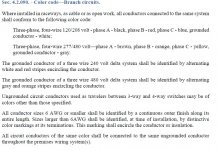There choices out there for a verity of marking. I feel this is so both 200.4 and 200.6 can be applied. In some AHJ areas a different identification method is required. This is for good reason. I worked in an area where branch circuit wiring of different systems had to be identified based on the system.
An example of this is where we had a 277/480 volt service with three SDS wich was 120/208 then we had a 240 volt three wire.
for the 277/480 volt system the had a rule of: Brown, Orange, Yellow, Gray. The SDS was 120/208 volt system Black,, Red ,Blue, White.
As long as the three different 120/208 volt systems did not occupy the any common enclosures White could be used with all three systems as long as all cover were properly marked. By this I mean what we usually do any way: LV-1, cir # 12 etc. The marking was an option as not listed in the amendments. Recommended however not mandated.
We were allowed to use a single or multiple striped running along the conductor as an identifier for all grounded conductors for the wye systems as long as it was maintained all the way through that system and did not as mentioned above.
Here is where it was tricky. It had a three wire 240 volt only corner grounded system as well. So the rules changed the white grounded phase conductor had to have a encircled identifier. In this case it was a red identifier. The B phase had to be the grounded phase. This meant these conductors had to be Black, White with Red circle and Blue.
Basically it was defined as WYE plain or striped running along the conductor. Delta encircled around the conductor.
The nice thing about this are of work was the AHJ worked closely with all the supply house in the area so the correct conductors were stocked even the Big Box stores. What happens is this information is not used correctly in the field in this area and many violations accrued. The guys buying wire started to make up there own rules when these types hit the supply house. Which was fine until a different system (s) was installed in the same building and then they failed. This was in new and remodel. The system identification legend was required to be at the point of entry of the service (s). The AHJ would go to this legend prior to his inspection, 200.6(D) (3) second paragraph.
I would recommend to read through article 200 closely paying attention to 200.6 and check for AHJ amendments. If a change in the NEC was made I would think the language should be thought through closely. See PIC.
Even with the AHJ rule you see that some latitude was given when it made good sense and made for a safer condition. The when it posed a hazard they did not and a correction was required. It pays to check and be up on local amendments and have a good working relation ship with the AHJ.
I also have worked in an area where we has to use a different striped wire for each systems grounded conductor using multiple SDS's. By this I mean white with back strip on system 1, white with Red on system 2, White with blue system 3 and so on. Now this was also a spec job. They felt it meant the intent of 200.6 (D). Sorry I do have a copy from spec book to show. This was years back.
On a personal note I would talk with the AHJ and explain your position discuss pros and cons and its impact on safety. You may be surprised.
Bull in china closet only breaks china.
I also have weekly conversations with other on the topic of article 200. When they miss use the word neutral which as fine as long as they know the difference. I usually start with turn your book open , if you have one and turn to article that applies please. They usually end up in the index.
" Neutral see also Conductors, grounded:
On an unrelated post on production versus experience. UMM, sure you would like to hear the whole story. Each has its place and one of them will not provide the other, choose wisely.
Edited


